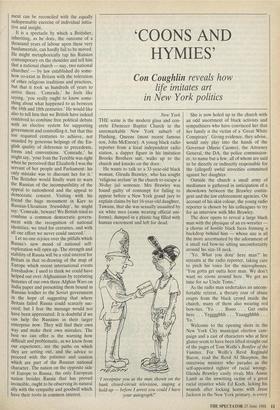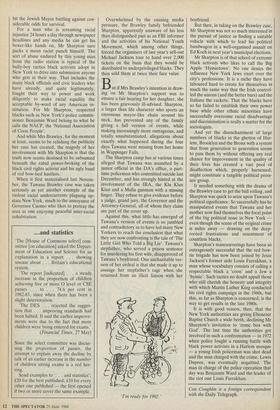`COONS AND HYMIES'
Con Coughlin reveals how
life imitates art in New York politics
New York THE scene is the modern glass and con- crete Ebenezer Baptist Church in the unremarkable New York suburb of Flushing, Queens (most recent famous son, John McEnroe). A young black radio reporter from a local independent radio station, a dapper figure in his imitation Brooks Brothers suit, walks up to the church and knocks on the door.
He wants to talk to a 33-year-old black woman, Glenda Brawley, who has sought `religious asylum' in the church to escape a 30-day jail sentence. Mrs Brawley was found guilty of contempt for failing to appear before a New York grand jury to explain claims by her 16-year-old daughter, Tawana, that she was sexually assaulted by six white men (some wearing official uni- forms), dumped in a plastic bag filled with human excrement and left for dead.
`I recognise you as the man shown on the bank closed-circuit television, staging a hold-up — before I arrest you could I have your autograph?' She is now holed up in the church with an odd assortment of black activists and sympathisers who have convinced her that her family is the victim of a 'Great White Conspiracy'. Giving evidence, they advise, would only play into the hands of the Governor (Mario Cuomo), the Attorney General, the DA, the police commission- er, to name but a few, all of whom are said to be directly or indirectly responsible for the (alleged) awful atrocities committed against her daughter.
Outside the church a small army of mediamen is gathered in anticipation of a showdown between the Brawley contin- gent and the law enforcement agencies. On account of his skin colour, the young radio reporter is chosen by his colleagues to try for an interview with Mrs Brawley.
The door opens to reveal a large black man with the physique of an ex-wrestler a chorus of hostile black faces forming a backdrop behind him — whose size is all the more accentuated by the adornment of a small red bow-tie sitting uncomfortably around his size-18 neck.
`Yo. What you doin' here man?' he screams at the radio reporter, taking care to pitch his voice for the microphones. `You gotta get outta here man. We don't want no coons around here. We got no time for no Uncle Toms.'
As the radio man undertakes an uncom- fortable retreat, a throaty roar of abuse erupts from the black crowd inside the church, many of them also wearing red bow-ties. 'Yo . . . B000 . . . Get outta here . . Yegggghhh . . . Yaaagghhhh . . Yo.'
Welcome to the opening shots in the New York City municipal election cam- paign and a cast of characters who at first glance seem to have been lifted straight out of the pages of Tom Wolfe's Bonfire of the Vanities. For Wolfe's Revd Reginald Bacon, read the Revd Al Sharpton, the streetwise minister who parades as the self-appointed righter of racial wrongs. Glenda Brawley easily rivals Mrs Annie Lamb as the unwitting victim of a great racial injustice while Ed Koch, licking his wounds after locking horns with Jesse Jackson in the New York primary, is every bit the Jewish Mayor battling against con- siderable odds for survival.
For a man who is screaming racial injustice 24 hours a day through newspaper headlines and any media he can get his boxer-like hands on, Mr Sharpton sure packs a mean racist punch himself. The sort of abuse endured by this young man from the radio station is typical of the bully-boy tactics black activists adopt in New York to drive into submission anyone who gets in their way. That includes the many black officials and civic leaders who have already, and quite legitimately, fought their way to power and work diligently to make racial equality the acceptable by-word of any American in- stitution. For Mr Sharpton, respected blacks such as New York's police commis- sioner Benjamin Ward belong to what he calls the NACP, the 'National Association of Coon People'.
And while Mrs Brawley, for the moment at least, seems to be relishing the publicity her case has created, the tragedy of her involvement with Mr Sharpton is that the truth now seems destined to be subsumed beneath the rabid power-broking of the black civil rights activist and his ugly band of red bow-tied hustlers.
When it first materialised last Novem- ber, the Tawana Brawley case was taken seriously as yet another example of the violent racial undercurrents plaguing up- state New York, much to the annoyance of Governor Cuomo who likes to portray the area as one enjoying peaceful inter-racial cohabitation. Overwhelmed by the ensuing media pressure, the Brawley family befriended Sharpton, apparently unaware of his less than distinguished past as an FBI informer and the activities of his National Youth Movement, which among other things, forced the organisers of last year's sell-out Michael Jackson tour to hand over 2,000 tickets on the basis that they would be distributed to underprivileged blacks. They then sold them at twice their face value.
But if Mrs Brawley's intention in draw- ing on Mr Sharpton's support was to ensure a fair hearing for her daughter, she has been grievously ill-advised. Sharpton, a larger than life character who sports an enormous mayor-like chain around his neck, has prevented any of the family giving a full version of events, while making increasingly more outrageous, and totally unsubstantiated, allegations about exactly what happened during the four days Tawana went missing from her home in Wappinger Falls.
The Sharpton camp has at various times alleged that Tawana was assaulted by a junior official in the DA's office, a part- time policeman who committed suicide last December, and has strongly hinted at the involvement of the IRA, the Klu Klux Klan and a Mafia gunman with a missing finger. They refuse to give evidence before a judge, grand jury, the Governor and the Attorney-General, all of whom they claim are part of the cover up.
Against this, what little has emerged of Tawana's version of events is so jumbled and contradictory as to have led many New Yorkers to reach the conclusion that what they are now confronting is the tale of 'The Little Girl Who Told a Big Lie'. Tawana's stepfather, who served a prison sentence for murdering his first wife, disapproved of Tawana's boyfriend. One uncharitable ver- sion of her ordeal is that she made it up to assuage her stepfather's rage when she returned from an illicit liaison with her ready for 1992.' boyfriend.
But then, in taking on the Brawley case, Mr Sharpton was not so much interested in the pursuit of justice as finding a suitable vehicle with which to lead his political bandwagon in a well-organised assault on Ed Koch in next year's municipal elections.
Mr Sharpton is of that school of extreme black activists who likes to call the Big Apple 'Hymietown'. No one denies the influence New York Jews exert over the city's professions. It is a niche they have laboured hard to create for themselves in much the same way that the Irish control- led the unions (and the better bars) and the Italians the rackets. That the blacks have so far failed to establish their own power base while other ethnic minorities have successfully overcome racial disadvantage and discrimination is really a matter for the sociologists.
And yet the disenchantment of large numbers of blacks in the ghettos of Har- lem, Brooklyn and the Bronx with a system that from generation to generation seems to pass them by without offering any real chance for improvement in the quality of their lives has created a vast pool of disaffection which, properly harnessed, might constitute a tangible political press- ure group.
It needed something with the drama of the Brawley case to get the ball rolling, and Sharpton was quick to seize upon Tawana's political significance. So successfully has he manipulated events that Tawana and her mother now find themselves the focal point of .the big political issue in New York even though the scene of the original crime is miles away — drawing on the deep- rooted frustrations and resentment of countless blacks.
Sharpton's maneuverings have been so outrageously successful that the red bow- tie brigade has now been joined by Jesse Jackson's former aide Louis Farrakhan, a man whose vocabulary consists of calling a respectable black a 'coon' and a Jew a `hymie'. Such tactics no doubt appall those who still cherish the honesty and integrity with which Martin Luther King conducted his civil rights campaign in the 1960s, but this, as far as Sharpton is concerned, is the way to get results in the late 1980s.
It is with good reason, then, that the New York authorities are giving Ebenezer Baptist Church a wide berth, declining Mr Sharpton's invitation to 'come box with God'. The last time the authorities got involved in such a confrontation — in 1972 when police fought a running battle with black power activists in a Harlem mosque — a young Irish policeman was shot dead and the man charged with the crime, Lewis Dupree, was eventually acquitted. The man in charge of the police operation that day *was Benjamin Ward and the leader of the riot one Louis Farrakhan.
Con Coughlin is a foreign correspondent with the Daily Telegraph.











































































 Previous page
Previous page